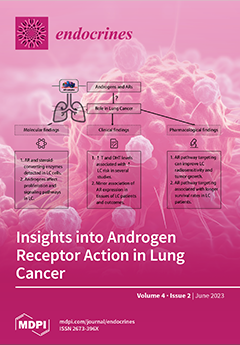Background: Obesity constitutes a chronic, low-grade inflammatory status that predisposes people to the development of insulin resistance and cardiometabolic complications. Hypoxia, a main pathological feature of visceral fat in obese individuals, has been shown to affect the secretome of murine 3T3-L1 adipose cells,
[...] Read more.
Background: Obesity constitutes a chronic, low-grade inflammatory status that predisposes people to the development of insulin resistance and cardiometabolic complications. Hypoxia, a main pathological feature of visceral fat in obese individuals, has been shown to affect the secretome of murine 3T3-L1 adipose cells, causing the upregulation of prothymosin-alpha (ProT-α), which is a protein with immunomodulatory functions that was originally found in the thymus. The aim of this case–control observational study was to measure the circulating levels of ProT-α in obese and lean individuals and determine whether such levels are correlated with inflammatory and metabolic parameters. Methods: Sixty-one obese patients (BMI ≥ 30 Kg/m
2) and fifty-one age-matched, lean controls (BMI 18.5–24.9 Kg/m
2) were recruited in the Endocrinology Unit (“Mater-Domini”) of the University Hospital of Catanzaro, Italy. The exclusion criteria included affliction with acute and systemic inflammatory states (i.e., leukocytosis), recent infectious diseases or vaccinations, obesity complications (i.e., type 2 diabetes mellitus and cardiovascular diseases), hepatic or renal failure, pregnancy and lactation, cancer, use of drugs or alcohol, and smoking. Apart from routine biochemical determinations, serum samples were screened for the presence of ProT-α using an ELISA method and for the presence of a panel of inflammatory cytokines and growth factors via a multiparametric chemiluminescence micro-array. Results: Between the age-matched groups, no statistically significant differences were shown in relation to fasting glucose, HbA1c, liver function tests, lipid profiles, circulating interleukins (IL)-1α, -1β, -2, -4, -8, and -10, MCP-1, TNF-α, VEGF and EGF. Instead, significantly higher median levels were observed in obese patients vs. lean controls with respect to fasting insulin levels (
p < 0.001), a classic insulin resistance marker, and IL-6 (
p = 0.004). In addition, ProT-α levels were significantly and considerably higher in obese patients compared to lean controls (median ProT-α, 600.0 vs. 411.5 pg/mL,
p = 0.004) and showed a moderate to strong positive relationship with fasting insulin levels and selected cytokines (i.e., TNF-α and IL-8). Conclusions: An increase in circulating levels of ProT-α is linked with obesity and can be detected before any clinical cardiometabolic complications develop. ProT-α may represent a novel and sensitive biomarker for inflammation and insulin resistance in obese individuals.
Full article




